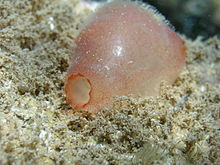| Ascidia | |
|---|---|

| |
| Scientific classification | |
| Domain: | Eukaryota |
| Kingdom: | Animalia |
| Phylum: | Chordata |
| Subphylum: | Tunicata |
| Class: | Ascidiacea |
| Order: | Phlebobranchia |
| Family: | Ascidiidae |
| Genus: | Ascidia Linnaeus, 1767 |
| Synonyms[1] | |
| |
Ascidia is a genus of tunicates in the family Ascidiidae.[1][2]
Selected species
[edit]
- Ascidia achimotae Millar, 1953
- Ascidia adamanensis Oka, 1915
- Ascidia ahodori Oka, 1927
- Ascidia alisea Monniot & Monniot, 2006
- Ascidia alpha Tokioka, 1953
- Ascidia alterna Monniot & Monniot, 1991
- Ascidia archaia Sluiter, 1890
- Ascidia arenosa Hartmeyer, 1898
- Ascidia armata Hartmeyer, 1906
- Ascidia aspera Brunetti, 2007
- Ascidia austera Sluiter, 1904
- Ascidia aximensis Millar, 1953
- Ascidia azurea Monniot & Monniot, 1996
- Ascidia bathybia Hartmeyer, 1922
- Ascidia bifissa Sluiter, 1895
- Ascidia bocatorensis Bonnet & Rocha, 2011[2]
- Ascidia caguayensis Millar & Goodbody, 1974
- Ascidia callosa Stimpson, 1852
- Ascidia canaliculata Heller, 1878
- Ascidia cannelata Oken, 1820
- Ascidia capillata Sluiter, 1887
- Ascidia caudata Heller, 1878
- Ascidia celtica C. Monniot, 1969
- Ascidia ceratodes (Huntsman, 1912)
- Ascidia challengeri Herdman, 1882
- Ascidia citrina Nishikawa & Tokioka, 1975
- Ascidia clementea Ritter, 1907
- Ascidia collini Bonnet & Rocha, 2011[2]
- Ascidia columbiana (Huntsman, 1912)
- Ascidia conchilega Muller, 1776
- Ascidia conifera (Hartmeyer, 1911)
- Ascidia corallicola Bonnet & Rocha, 2011[2]
- Ascidia correi C. Monniot, 1970
- Ascidia curvata (Traustedt, 1882)
- Ascidia decepta Kott, 1985
- Ascidia depressiuscula Heller, 1878
- Ascidia despecta Herdman, 1880
- Ascidia dijmphniana Templeton, 1834
- Ascidia dorsata Meenakshi & Renganathan, 1999
- Ascidia empheres Sluiter, 1895
- Ascidia escabanae Monniot, 1998
- Ascidia fictile Monniot, 1997
- Ascidia fistulosa Monniot & Monniot, 1967
- Ascidia formella Monniot, 1998
- Ascidia fusca Monniot & Monniot, 1989
- Ascidia gamma Tokioka, 1954
- Ascidia gemmata Sluiter, 1895
- Ascidia glabra Hartmeyer, 1922
- Ascidia hyalina Oka, 1915
- Ascidia iberica C. Monniot & F. Monniot, 1988
- Ascidia incrassata Heller, 1878
- Ascidia interrupta Heller, 1978
- Ascidia involuta Heller, 1875
- Ascidia irregularis Oka, 1915
- Ascidia kreagra Sluiter, 1895
- Ascidia krechi Michaelsen, 1904
- Ascidia kuneides Sluiter, 1887
- Ascidia lagena Michaelsen, 1922
- Ascidia latesiphonica Hartmeyer, 1922
- Ascidia liberata Sluiter, 1887
- Ascidia limpida Sluiter, 1904
- Ascidia longistriata Hartmeyer, 1906
- Ascidia macropapilla Millar, 1982
- Ascidia malaca (Traustedt, 1883)
- Ascidia matoya Tokioka, 1949
- Ascidia mediterranea Pérès, 1959
- Ascidia melanostoma Sluiter, 1885
- Ascidia mentula Müller, 1776
- Ascidia meridionalis Herdman, 1880
- Ascidia molguloides C. Monniot, 1975
- Ascidia monnioti Bonnet & Rocha, 2011[2]
- Ascidia multitentaculata (Hartmeyer, 1912)
- Ascidia munda Sluiter, 1897
- Ascidia muricata Heller, 1874
- Ascidia nerea Kott, 1985
- Ascidia nordestina Bonnet & Rocha, 2011
- Ascidia nuda Nishikawa, 1986
- Ascidia obliqua Alder, 1863
- Ascidia obocki Sluiter, 1905
- Ascidia occidentalis Kott, 1985
- Ascidia ornata Monniot & Monniot, 2001
- Ascidia pacifica Tokioka, 1967
- Ascidia panamensis Bonnet & Rocha, 2011[2]
- Ascidia papillata Bonnet & Rocha, 2011
- Ascidia papillosa Tokioka, 1967
- Ascidia parasamea Kott, 1985
- Ascidia paratropa (Huntsman, 1912)
- Ascidia perfluxa Sluiter, 1904
- Ascidia placenta Herdman, 1880
- Ascidia polytrema Herdman, 1906
- Ascidia prolata Kott, 1985
- Ascidia prona Monniot & Monniot, 1994
- Ascidia prunum Müller, 1776
- Ascidia pygmaea Michaelsen, 1918
- Ascidia retinens Monniot, 1984
- Ascidia retrosipho Millar, 1988
- Ascidia saccula Kott, 2006
- Ascidia sagamiana Tokioka, 1953
- Ascidia salvatoris (Traustedt, 1885)
- Ascidia samea Oka, 1935
- Ascidia santosi Millar, 1958
- Ascidia savignyi Hartmeyer, 1915
- Ascidia scaevola (Sluiter, 1904)
- Ascidia scalariforme Bonnet & Rocha, 2011
- Ascidia spinosa Sluiter, 1904
- Ascidia stenodes Millar, 1962
- Ascidia stewartensis Millar, 1982
- Ascidia subterranea Kneer et al., 2013[3]
- Ascidia sulca Monniot, 1991
- Ascidia sydneiensis Stimpson, 1855
- Ascidia tapuni Monniot & Monniot, 1987
- Ascidia tenera Herdman, 1880
- Ascidia tenue Monniot, 1983
- Ascidia thompsoni Kott, 1952
- Ascidia translucida Sluiter, 1890
- Ascidia tricuspis Sluiter, 1904
- Ascidia tritonis Herdman, 1883
- Ascidia trunca Brunetti, 2007
- Ascidia unalaskensis (Ritter, 1913)
- Ascidia urnalia Monniot, 1994
- Ascidia vermiformis (Ritter, 1913)
- Ascidia virginea Müller, 1776
- Ascidia willeyi Oka, 1915
- Ascidia xamaycana Millar & Goodbody, 1974
- Ascidia zara Oka, 1935
- Ascidia zyogasima Tokioka, 1962
References
[edit]- ^ a b Karen Sanamyan & Claude Monniot (2013). Shenkar N, Gittenberger A, Lambert G, Rius M, Moreira Da Rocha R, Swalla BJ, Turon X (eds.). "Ascidia Linnaeus, 1767". Ascidiacea World Database. World Register of Marine Species. Retrieved February 25, 2012.
- ^ a b c d e f N. Y. K. Bonnet & R. M. Rocha (2011). "The family Ascidiidae Herdman (Tunicata: Ascidiacea) in Bocas del Toro Panama. Description of six new species". Zootaxa. 2864: 1–33. doi:10.11646/zootaxa.2864.1.1.
- ^ Dominik Kneer; Françoise Monniot; Thomas Stach; Marjolijn J; . A. Christianen (2013). "Ascidia subterranea sp. nov. (Phlebobranchia: Ascidiidae), a new tunicate belonging to the A. sydneiensis Stimpson, 1855 group, found as burrow associate of Axiopsis serratifrons A. Milne-Edwards, 1873 (Decapoda: Axiidae) on Derawan Island, Indonesia" (PDF). Zootaxa. 3616 (5): 485–494. doi:10.11646/zootaxa.3616.5.5.
External links
[edit] Media related to Ascidia at Wikimedia Commons
Media related to Ascidia at Wikimedia Commons
Well, that’s interesting to know that Psilotum nudum are known as whisk ferns. Psilotum nudum is the commoner species of the two. While the P. flaccidum is a rare species and is found in the tropical islands. Both the species are usually epiphytic in habit and grow upon tree ferns. These species may also be terrestrial and grow in humus or in the crevices of the rocks.
View the detailed Guide of Psilotum nudum: Detailed Study Of Psilotum Nudum (Whisk Fern), Classification, Anatomy, Reproduction